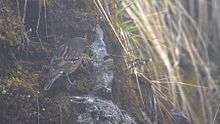Alpine accentor
| Alpine accentor | |
|---|---|
 | |
| From Pangolakha WLS in East Sikkim, India. | |
 | |
| Alpine accentor (adult) from Castellón, Valencia, Spain | |
| Scientific classification | |
| Kingdom: | Animalia |
| Phylum: | Chordata |
| Class: | Aves |
| Order: | Passeriformes |
| Suborder: | Passeri |
| Infraorder: | Passerida |
| Superfamily: | Passeroidea |
| Family: | Prunellidae |
| Genus: | Prunella |
| Species: | P. collaris |
| Binomial name | |
| Prunella collaris (Scopoli, 1769) | |
| Synonyms | |
|
Laiscopus collaris | |
The alpine accentor (Prunella collaris) is a small passerine bird.
Taxonomy and etymology
The word "accentor" is from post-classical Latin and means a person who sings with another.[2] The genus name Prunella is from the German Braunelle, "dunnock", a diminutive of braun, "brown", and the specific collaris is from Latin collum, "neck".[3]
This species, along with the Altai accentor is sometimes separated from the other accentors, into the genus Laiscopus.[4]
Description

This is a robin-sized bird at 15-17.5 cm in length, slightly larger than its relative, the dunnock. It has a streaked brown back, somewhat resembling a house sparrow, but adults have a grey head and red-brown spotting on the underparts. It has an insectivore's fine pointed bill.
Sexes are similar, although the male may be contrasted in appearance. Young birds have browner heads and underparts.
Distribution and habitat
It is found throughout the mountains of southern temperate Europe, Lebanon[5] and Asia at heights above 2000 m. It is mainly resident, wintering more widely at lower latitudes, but some birds wander as rare vagrants as far as Great Britain.
It is a bird of bare mountain areas with some low vegetation.
Breeding
It builds a neat nest low in a bush or rock crevice, laying 3-5 unspotted sky-blue eggs.
The mating system is of particular interest. Home ranges are occupied by breeding groups of 3 or 4 males with 3 or 4 females. These are unrelated birds which have a socially polygynandrous mating system. Males have a dominance hierarchy, with the alpha males being generally older than subordinates. Females seek matings with all the males, although the alpha male may defend her against matings from lower ranking males. In turn, males seek matings with all the females. DNA fingerprinting has been used to show that, within broods, there is often mixed paternity, although the female is always the true mother of the nestlings raised within her nest. Males will provide food to chicks at several nests within the group, depending on whether they have mated with the female or not - males only provide care when they are likely to be the true fathers of the chicks.
References
- ↑ BirdLife International (2012). "Prunella collaris". IUCN Red List of Threatened Species. Version 2013.2. International Union for Conservation of Nature. Retrieved 26 November 2013.
- ↑ "Accentor". Oxford English Dictionary (3rd ed.). Oxford University Press. September 2005. (Subscription or UK public library membership required.)
- ↑ Jobling, James A. (2010). The Helm Dictionary of Scientific Bird Names. London, United Kingdom: Christopher Helm. pp. 113, 318. ISBN 978-1-4081-2501-4.
- ↑ HBW volume 10, page 496
- ↑ http://www.lebanonhunt.com
Further reading
- Davies, N. B., Hartley, I. R., Hatchwell, B. J., Desrochers, A., Skeer, J. & Nebel, D. 1995. The polygynandrous mating system of the alpine accentor Prunella collaris. I. Ecological causes and reproductive conflicts. Animal Behaviour, 49, 769-788.
- Davies, N. B., Hartley, I. R., Hatchwell, B. J. & Langmore, N. E. 1996. Female control of copulations to maximise male help: a comparison of polygynandrous alpine accentors Prunella collaris and dunnocks Prunella modularis. Animal Behaviour, 51, 27-47.
- Hartley, I. R., Davies, N. B., Hatchwell, B. J., Desrochers, A., Nebel, D. & Burke, T. 1995. The polygynandrous mating system of the alpine accentor Prunella collaris. II. Multiple paternity and parental effort. Animal Behaviour, 49, 789-803.
External links
- Alpine accentor videos, photos & sounds on the Internet Bird Collection
